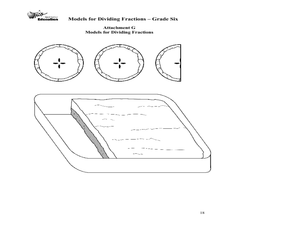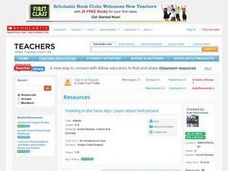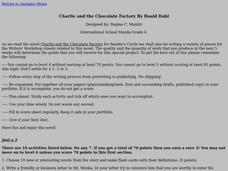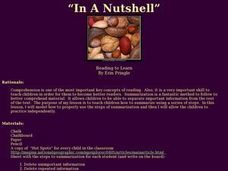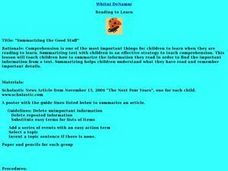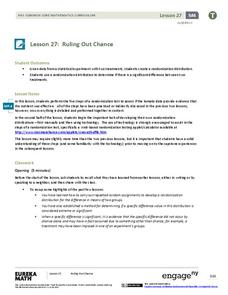Ohio Department of Education
Models for Dividing Fractions - Grade Six
Fifth and sixth graders use food and candy to help them represent division of fractions and develop algorithms to solve fraction problems. They discuss dividing whole numbers by fractions. Pupils use sticks and chocolate bars to study...
Curated OER
Reading the Movies: Another Approach To Teaching Critical Thinking Skills And Writing
Students explore the elements of film to analyze character, action, and the themes in the movie, "Quiz Show." The lesson encourages students to make personal connections and real life applications as they view the movie, critically.
Curated OER
Lesson 5:Web Page
Students create a webpage. In this technology lesson, students choose a topic and work in groups to create their own webpage using Microsoft Frontpage. This lesson includes directions on how to make webpages and cover pages.
Curated OER
HOT TOPICS OF THE MISSISSIPPI
Students use a five-step process to write a persuasive essay about an issue that is related to the Mississippi River. Students build an argument based on prior knowledge and information from a variety of sources. Students base their...
Curated OER
Publishing Autobiographies
Middle schoolers practice using Microsoft word. Individually, each student writes a mini-autobiography in standard typed format. They title each paragraph and discuss the publishing steps of the writing process. Students explore...
Curated OER
Making a Quilt
Students use vocabulary to describe the quilt making process. In this quilting instructional activity, students collect needed materials, sequence the steps for quilting and create an original peace quilt. Students write about their quilts.
Curated OER
The Butterfly
Sixth graders investigate Germany during World War II. In this world history lesson, 6th graders research the Nazi's during World War II writing a summary of what they find after listening to the story known as The Butterfly.
Curated OER
Give a Hoot About Owls
Students research basic information about owls. They complete a class KWL chart, and conduct research on owls using the Internet and a variety of resource books. Next, they write an owl acrostic poem and a report using their research...
Curated OER
Yodeling in the Swiss Alps
Middle schoolers become familiar with the country of Switzerland, its geography and yodeling music. In this Switzerland lesson, students recognize that Swiss cheese is a producct of Switzerland and write about the process of making...
Curated OER
Ink Analysis and Thin Layer Chromatography
Students explain the process of TLC. They identify at least three components of ink. They analyze data and make conclusions based on laboratory observations.
Curated OER
Charlie and the Chocolate Factory
Fourth graders read the novel Charlie and the Chocolate Factory for Reader's Circle, they also are writing a variety of pieces for the Writer's Workshop that is closely related to the novel. The quality and the quantity of work that...
Curated OER
Argumentation and Logic
Students recognize inductive and deductive reasoning and analyze common fallacies in critical thinking. In this argumentation and logic lesson, students use role playing activities and specific instances of inductive and deductive...
Curated OER
A Pixie Biography Report
Students practice biographical writing after completing research on the subject. In this journalism lesson plan, students read a story of an important person's life and discuss the important moments along the way. Students utilize...
Curated OER
The 3 R's of Common Denominators (Language)
Pupils solve various word problems that deal with common denominators, and write the mathematical explanations they used to obtain the solutions.
Curated OER
In a Nutshell
Students summarize a non-fiction article in this lesson. They review a six step process for summarization. They then read the assigned article, and work as a class to write a summary using the five steps provided. They then write an...
Curated OER
Summarize What You Read
Third graders summarize a selected piece of nonfiction text. After reviewing the correct way to use a Venn diagram, 3rd graders read a nonfiction article. They write a summary paragraph using their Venn Diagram and the five-step process...
Curated OER
Summarizing the Good Stuff
Learners summarize a selected piece of text nonfiction text. After reviewing the correct way to read silently, students read a nonfiction article. Working in groups, they write a summary paragraph using the five step process outlined by...
Curated OER
Titanic
Pupils conduct research with the purpose of writing a report about the Titanic. They use a variety of resources. The students produce a written document that has plenty of documented information. They also compare the information that is...
Curated OER
Documenting Science Through an Active Inquiry Process
Students follow procedures regarding scientific data collection. In this scientific inquiry lesson, students investigate inquiry questions through research and data collection. Students use technology tools to create products that...
EngageNY
Ruling Out Chance (part 3)
Pupils analyze group data to identify significant differences. They use simulation to create their own random assignment data for comparison.
EngageNY
Solve for Unknown Angles—Angles and Lines at a Point
How do you solve for an unknown angle? In this sixth installment of a 36-part series, young mathematicians use concepts learned in middle school geometry to set up and solve linear equations to find angle measures.
Curated OER
Interviewing Skills
Prepare your pupils for the world of work and the dreaded interview by providing class members with a resource packet that includes handy tips. After examining the materials, pairs conduct mock interviews and reflect on the experience....
Curated OER
Eating Your Words!
First graders study how to complete activities in sequential steps. They participate in various activities describing each step needed to complete the tasks. They work in pairs to type the list of steps necessary in making a sandwich. ...
Curated OER
Use of Literature in SDMPS
Young scholars demonstrate their knowledge of the eight step problem solving process. They describe how the story would change according to the solution chosen, then rewrite an ending to the story based upon a solution other than the one...


